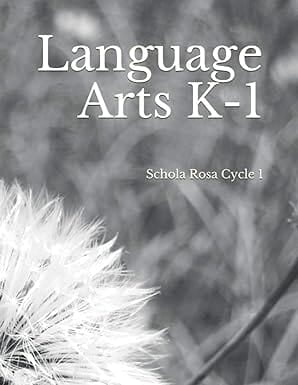Language Arts K-1: Schola Rosa Cycle 1
Language Arts, Primary Level (K – 3rd Grade)
Goals. There are four general goals for the program:
To lead children, grades Kindergarten through Third, into the habit of speaking and writing the English language correctly
To provide drills which emphasize reproduction of many of the short stories in modern literary classics
To introduce practice exercises to familiarize students with correct forms through inductive reasoning.
Lesson Types & Suggestions to Teachers. It is not intended that each lesson shall represent one day’s work. The teacher or parent, knowing the capabilities of her students, can best determine the amount of work that should be done. Some of the lessons will doubtless require part of many days.
Method. It is assumed that the student will learn to speak and write correctly, by imitation, if the proper forms are presented to him. The main idea is that the best results in the use of good English come from continued practice on correct forms rather than from the learning of many rules. Accordingly much attention is given in the lessons to expressions frequently misused, as for example, troublesome verb forms. The lessons are designed, as well, to awaken and sustain children’s interest in natural objects, and to put them in sympathetic relations with living things.
Dictation Lessons (2nd-3rd Grade). In giving a dictation lesson, the parent should read each sentence once. The sentences in the lesson have been made short so that they can be retained easily in the student’s memory. The results of the student’s work should be carefully noted by the parent, attention being called to mistakes in spelling, capitalization, and punctuation, or to failure to reproduce the exact words dictated. Careful work in these dictated lessons and frequent drills on the lists containing “troublesome words” are sure to produce good results in written composition.
Selections to be Memorized (K – 1st Grade; 2nd-3rd Grade). These selections should be read to the students and discussed with them before being memorized.
Narration & Drawing (K – 1st Grade; 2nd – 3rd Grade). There are weekly narration and drawing lessons. The purpose is not to obtain finely finished pictures or perfect stories, but to secure the representation of ideas. Let the students select the central theme of the story to be told and the picture to be drawn, and then decide on a fitting background and surroundings.
Picture Studies (primarily K – 1st Grade; also 2nd – 3rd Grade). Most of the pictures used are copies of works of great artists. A few suggestive questions are given with each picture, but the parent should supplement these with many others.
Nature & Observation Lessons (K – 1st Grade; 2nd – 3rd Grade). These lessons should be introduced by oral discussions covering the points indicated by the questions or directions. After the discussion, a student should read the questions silently, and then give the answer aloud as a complete sentence. As the student progresses, these answers may be written, but they should always be preceded by the oral discussion.
Grammar Lessons, or Lessons on Troublesome Forms (2nd – 3rd Grade). These lessons should be repeated many times, not at a single period or at succeeding ones, necessarily, but at different times during the year. A little quick work on preceding lessons fixes important forms as no single treatment can do.
Challenges. Pay close attention to your student’s speech and writing and use lessons again when needed to reinforce correct English.
Choose Quantity
$20.35

